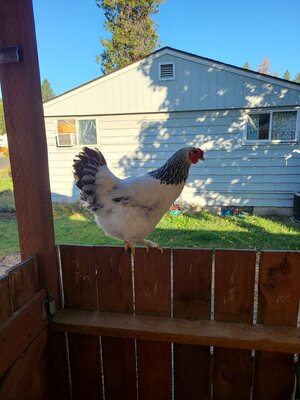Returnofsid
In the Brooder
- May 9, 2020
- 11
- 15
- 23
Hi all. My daughter and I have been in the process of building a bigger coop for her small flock. The coop is a 4' front to back x8' wide box, with a slanted roof. The box height is 4' at the front, and slopes to 3' at the back. I'll attempt to add photos. For clarification. The nesting boxes will be completely inside. In other words, they don't "bump out" from the coop. The coop is on legs and is raised 2' off the ground.
I have questions about nesting boxes, roost size and placement, ventilation, heating, and I'm sure I'll have more questions as we progress.
My plan is to build 4 nesting boxes, 12"x14", we currently have 4 Buff Orphingtons, but will add more in the spring. Must the nesting boxes be positioned higher than floor level? I had planned on the nesting boxes being at floor level, but could raise them a few inches, if necessary.
I plan to build 2 roosting bars, each spanning the 4' depth, and at a height of 18" and 24". This will give them about 18" and 24" of space, under the roof, in the tall side, and about 12" and 16" on the short side. These are rough measurements. Are the levels acceptable? I had originally planned on using 1 1/2" wooden dowels, but have been reading that this may not be the best option. Would 2x4s placed horizontally be a better option? Do they need ladders?
Venting, lighting and heating. We live in Spokane, WA. Hot in the summer and Cold in the winter. During warm weather, the chickens have full run of our fence back yard.




For ventilation, there will be 2 windows, that can be open or closed. There will also be 2 or 3 round holes cut, at 2" diameter. These will have round vent covers over them. Will this 2" vents provide enough venting, without creating a bad draft?
Lighting. I plan to add a small night light, to extend morning daylight hours, during the winter. Acceptable?
Heating. I had originally planned on utilizing a infrared heat lamp at the high point, and nowhere near the roosts. I would hang it from the ceiling, and space it away from any wooden walls. But I'm reading that this may not be a good idea. What other options would you recommend, or is the infrared light a safe alternative?
In the photos, the ramp is temporary, and will have thin boards crossing it. The legs will be wrapped with wire, to allow a run underneath, as well as an extended run outside the ramp door. The ramp opening will have a door that can be closed, during cold times.
I'm still trying to figure out an option to attach wheels lol. My daughter will begin painting today, and says it's going to be very colorful.
I have questions about nesting boxes, roost size and placement, ventilation, heating, and I'm sure I'll have more questions as we progress.
My plan is to build 4 nesting boxes, 12"x14", we currently have 4 Buff Orphingtons, but will add more in the spring. Must the nesting boxes be positioned higher than floor level? I had planned on the nesting boxes being at floor level, but could raise them a few inches, if necessary.
I plan to build 2 roosting bars, each spanning the 4' depth, and at a height of 18" and 24". This will give them about 18" and 24" of space, under the roof, in the tall side, and about 12" and 16" on the short side. These are rough measurements. Are the levels acceptable? I had originally planned on using 1 1/2" wooden dowels, but have been reading that this may not be the best option. Would 2x4s placed horizontally be a better option? Do they need ladders?
Venting, lighting and heating. We live in Spokane, WA. Hot in the summer and Cold in the winter. During warm weather, the chickens have full run of our fence back yard.
For ventilation, there will be 2 windows, that can be open or closed. There will also be 2 or 3 round holes cut, at 2" diameter. These will have round vent covers over them. Will this 2" vents provide enough venting, without creating a bad draft?
Lighting. I plan to add a small night light, to extend morning daylight hours, during the winter. Acceptable?
Heating. I had originally planned on utilizing a infrared heat lamp at the high point, and nowhere near the roosts. I would hang it from the ceiling, and space it away from any wooden walls. But I'm reading that this may not be a good idea. What other options would you recommend, or is the infrared light a safe alternative?
In the photos, the ramp is temporary, and will have thin boards crossing it. The legs will be wrapped with wire, to allow a run underneath, as well as an extended run outside the ramp door. The ramp opening will have a door that can be closed, during cold times.
I'm still trying to figure out an option to attach wheels lol. My daughter will begin painting today, and says it's going to be very colorful.





